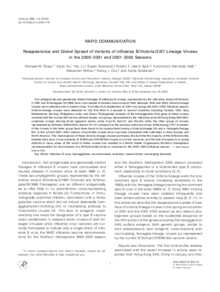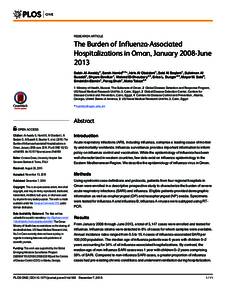Document
Reappearance and global spread of variants of influenza B/Victoria/2/87 lineage viruses in the 2000-2001 and 2001-2002 seasons.
Identifier
DOI: 10.1006/viro.2002.1719
Source
Virology. v. 303, 1, p. 1-8
Contributors
Xu, Xiyan., Author
Li, Yan., Author
Normand, Susan., Author
Ueki, Robert T., Author
Kunimoto, Gail Y., Author
Hall, Henrietta., Author
Klimov, Alexander., Author
Cox, Nancy J., Author
Subbarao, Kanta., Author
Country
United States.
City
Cambridge
Publisher
Academic Press Inc.
Gregorian
2002-11-10
Language
English
Subject
English abstract
Two antigenically and genetically distinct lineages of influenza B viruses, represented by the reference strains B/Victoria/2/1987 and B/Yamagata/16/1988, have cocirculated in humans since at least 1983. Between 1992 and 2000, Victoria lineage viruses were detected only in eastern Asia. From March to September of 2001 and during the 2001-2002 influenza season, Victoria lineage viruses were detected for the first time in a decade in several countries including Canada, USA, Italy, Netherlands, Norway, Philippines, India, and Oman. Phylogenetic analysis of the hemagglutinin (HA) gene of these viruses revealed that the viruses fell into two distinct clades: one group, represented by the reference strain B/Hong Kong/330/2001, contained viruses sharing three signature amino acids, Arg116, Asn121, and Glu164, while the other group of viruses, represented by B/Oman/16296/2001, shared Thr121 compared to the previous reference strain, B/Shandong/7/97. A number of the viruses in the latter group have been found to be reassortants having a Victoria lineage HA and a Yamagata lineage NA. In the current 2001-2002 season, Victoria-like viruses have now been associated with outbreaks in Asia, Europe, and North America. The reemergence of these Victoria lineage viruses worldwide, the fact that the majority of the B/Victoria-like isolates have poor cross-reactivity to B/Sichuan/379/99-like viruses in current vaccines, and the lack of exposure of young children in many areas of the world to these viruses has resulted in a World Health Organization Northern Hemisphere recommendation for the inclusion of a B/Victoria-like strain in vaccines for the 2002-2003 influenza season.
ISSN
0042-6822
Category
Journal articles


